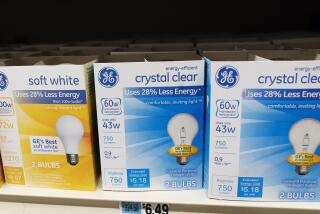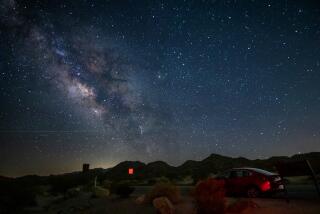Revolutionary Light Bulb Saves Energy, Lasts Longer
In what is hailed as the first major advance in electric lighting in 60 years, a Sunnyvale company has developed what it says is a revolutionary light bulb that will last up to 20,000 hours, fit into ordinary sockets and use 75% less electricity than conventional incandescent lights.
Known as an electronic light, or “E-Lamp,” the bulb would hold enormous potential for dramatically reducing the nation’s $30-billion annual lighting bill and allowing utilities to build fewer polluting power plants at a time of mounting worldwide concern over global warming.
Production is scheduled to begin early next year on a limited basis, and backers are hoping for widespread residential and commercial use within several years.
The breakthrough, to be announced Monday by Intersource Technologies Inc. of Sunnyvale and American Electric Power Co. Inc. of Columbus, Ohio, at the annual meeting of the Edison Electric Institute in Columbus, uses advances in microelectronics to develop a different way of creating light.
Unlike conventional incandescent and fluorescent lights, the new bulb has no filament--the major cause of bulb failure. Instead, a magnetic coil inside a gas-filled light bulb generates a high-frequency radio signal that converts it to plasma, or ionized gas. The plasma emits an invisible light that strikes a phosphor coating on the inside of the bulb, which glows with visible light.
Although the theory behind such lighting has been around since at least the 1970s, recent advances in microelectronics and renewed government interest in energy efficiency were needed to develop a practical light bulb.
The last major advance over Thomas A. Edison’s venerable incandescent light bulb, invented in 1879, was the development of the fluorescent light in the 1930s.
“We think it is the most significant advance in high-efficient incandescent alternative lighting that’s happened,” said Pierre G. Villere, chairman and chief executive officer of Intersource. “There have been very, very few advances in lighting in the last 112 years since Edison’s greatest single invention.”
Richard E. Disbrow, chairman and chief executive officer of American Electric Power Company Inc., said the bulb “could well turn into one of the fundamental answers to energy conservation.” The company, an electrical utility that serves seven states, has invested $6.5 million in the bulb’s development.
Before the firm invested in the product, it verified Intersource’s performance claims independently, officials said.
Officials of the California Energy Commission and the U. S. Department of Energy welcomed the announcement as an important advance in lighting technology.
“The technology is one that is proven,” said Fred Barryman, the commission’s lighting program specialist. “It’s a pretty basic difference from previous lamp types. . . . It’s a significant addition to the technology.”
Although lighting systems have become more efficient in the past decade, there was little doubt that considerably more gains were possible. For example, 95% of the electricity that flows through the incandescent bulb is converted to heat, with only 5% converted to light. The bulb’s tungsten filament is heated by electricity until it glows.
“Incandescent lighting by (its) nature is mostly a heater,” Barryman said.
Lighting consumes 25% of all electrical power in the United States and accounts for 40% or more of electricity bills for businesses.
Despite its drawbacks, the incandescent bulb remains the most widely used household light in the world. More than 1.4 billion such bulbs were sold in the United States in 1989.
By contrast, the E-Lamp and compact fluorescent lights are three or four times more efficient in converting electricity into visible light.
Although the new electronic bulb will cost between $10 and $20--about the same as compact fluorescent bulbs--it is expected to last up to twice as long as a compact fluorescent light, Villere said. It has the coloration, brightness and shape of conventional incandescent bulbs.
In addition, the E-Lamp has no characteristic fluorescent flicker when it is turned on, another energy saving. And, unlike the conventional fluorescent light, the E-Lamp can be dimmed.
These last two characteristics, developers say, could make the bulb especially attractive to businesses investing in lighting controls that turn lights on and off automatically.
Because fluorescent and incandescent bulbs have filaments, repeated switching on and off shortens their lives. The E-Lamp dims gradually as the phosphor coating on the inside of its globe ages. It would become noticeable after 15,000 to 20,000 hours, developers say.
In homes, an electronic light could save $50 to $100 over its 15- to 20-year life based on its reduced operating cost and less frequent replacement, Villere said. The most durable incandescent bulbs last about 1,500 hours. Such savings would be multiplied by the number of incandescent bulbs replaced. The average home has 20 incandescent bulbs, Intersource officials said.
The new bulb’s energy efficiency--in effect getting more light per kilowatt-hour--could also make it an attractive option for electrical utilities looking for alternatives to building generating plants. Such avenues to reducing energy by consumers are known by utilities as “demand-side management” alternatives.
Once other utilities become aware of the new bulb, Disbrow said, they may choose to incorporate it into their plans.
Initially, the new lights produced for residential use will be purchased by utility companies and made available to their customers as a way of meeting growing demands for electricity by using generating capacity more efficiently, Disbrow said.
Additional capital must be raised to market the bulb, making it unlikely that the bulbs will be available at retail outlets in the next several years.
In California, the state Energy Commission is projecting a need for an additional 11,000 megawatts of electricity by 2000 to meet growth. But three-fourths of that new demand is supposed to be met through conservation achieved by demand-side management alternatives. The state now generates 55,000 megawatts.
Known as air-core-induction lighting, the technology was invented in the 1970s by Donald Hollister in conjunction with the U. S. Department of Energy, Villere said.
But several factors worked against its perfection. Research funds dried up during the Reagan Administration, which all but abandoned an effort launched by President Jimmy Carter to promote greater energy efficiency and the development of alternative energy sources. Tax incentives were withdrawn and commercial interest in the technology waned.
Diablo Research Corp. acquired the technology. In 1990, Intersource obtained exclusive worldwide licensing rights and engaged Diablo to complete the engineering, made possible by advances in microelectronics and reductions in the cost of components.
On Friday, Intersource signed a joint venture agreement with Magnetek of Los Angeles, a Fortune 500 company, to distribute and sell the lamp in the United States and selected overseas markets.
The E-Lamp
The “E-Lamp” is called a major breakthrough in electric light technology. Unlike conventional incandescent and fluorescent lights, the electronic E-Lamp has no filament to burn out.
A magnetic coil or energy coupling antenna generates a high-frequency radio signal.
As the radio signal passes through a gas (the same gas--argon and mercury--found in conventional fluorescent bulbs) the gas is converted into a plasma, or ionized state.
The plasma emits invisible light, striking a phosphor coating on the inside of the glass, which then glows with visible light.
The makers claim the new light bulb will last up to 20,000 hours. If a light is burned three hours a day, it would last more than 18 years. Its cost is far higher than a conventional incandescent light bulb and about the same as a compact fluorescent--$10 to $20 each. But the bulb’s makers say it would save consumers between $50 and $100 over its 20,000-hour lifetime by using 75% less electricity and lasting longer.
Traditional light bulbs consist of a filament of tungsten wire wound in a tight coil. Electricity passes through the filament, heating it until it glows with visible light. But this method is inefficient. In the traditional light bulb, 95% of the electricity is converted to heat and only 5% to light.
More to Read
Inside the business of entertainment
The Wide Shot brings you news, analysis and insights on everything from streaming wars to production — and what it all means for the future.
You may occasionally receive promotional content from the Los Angeles Times.









